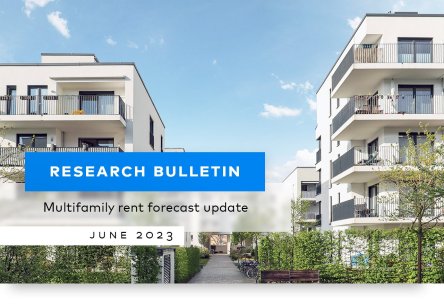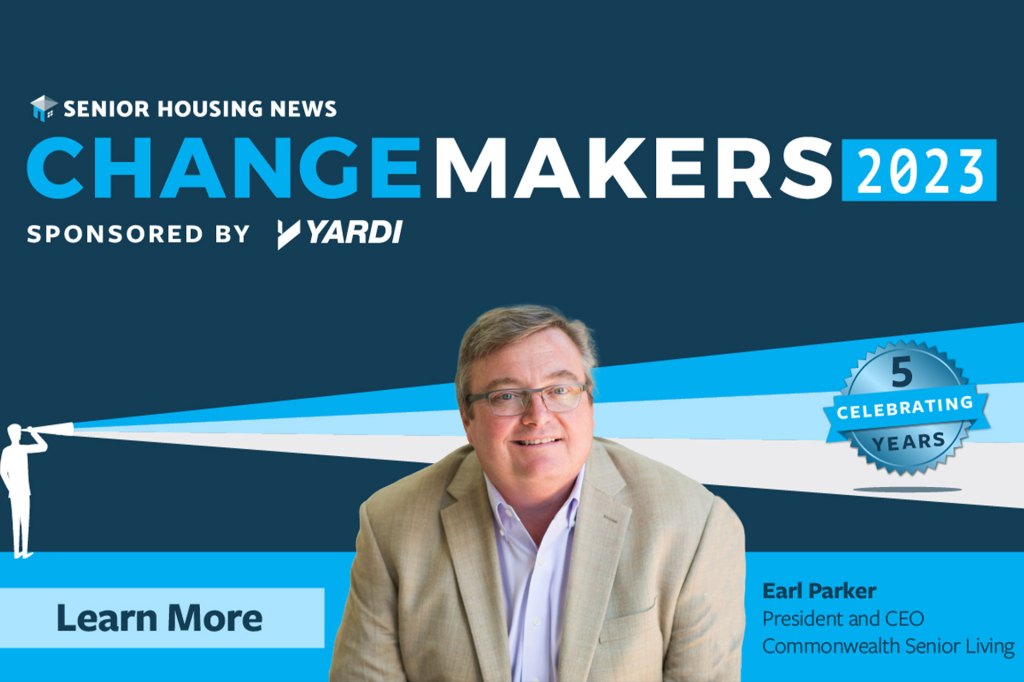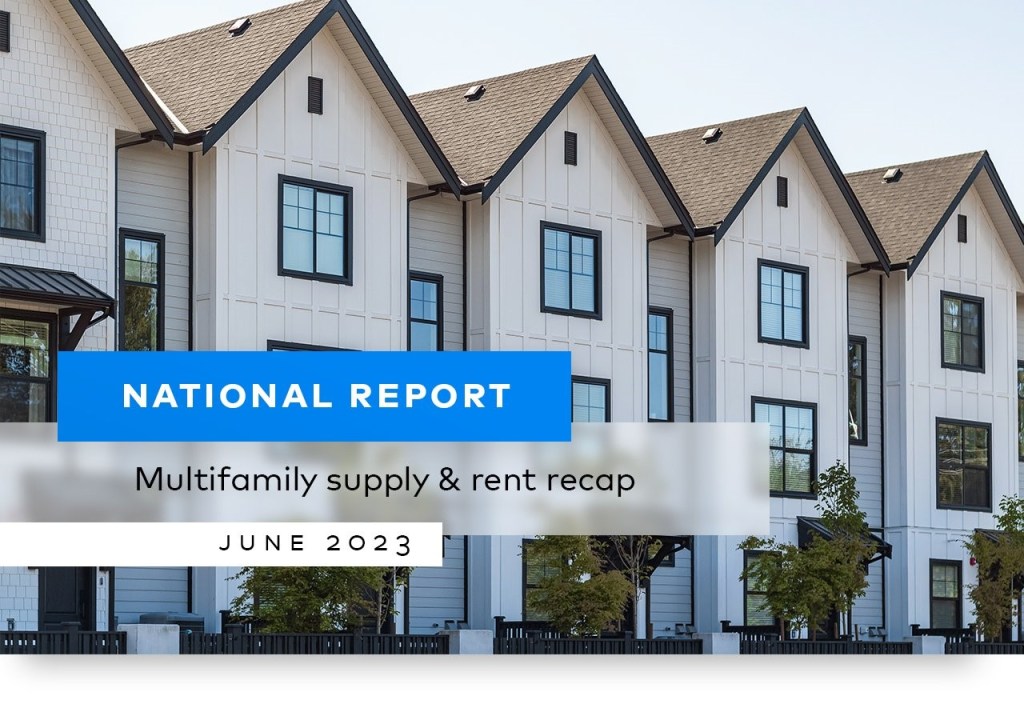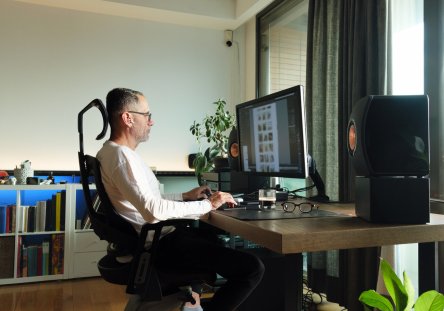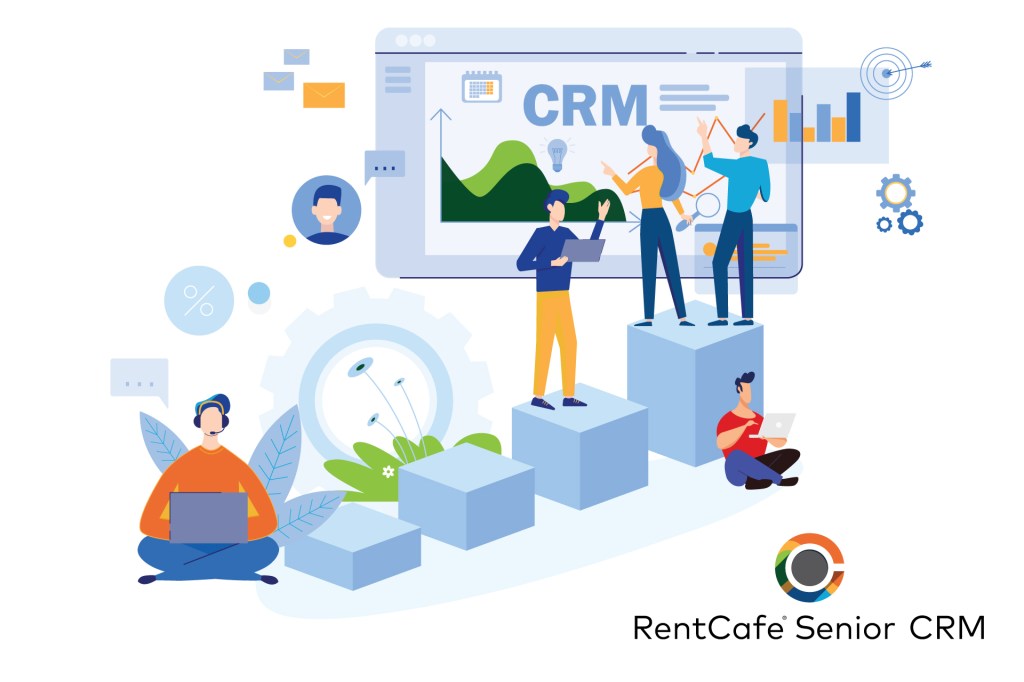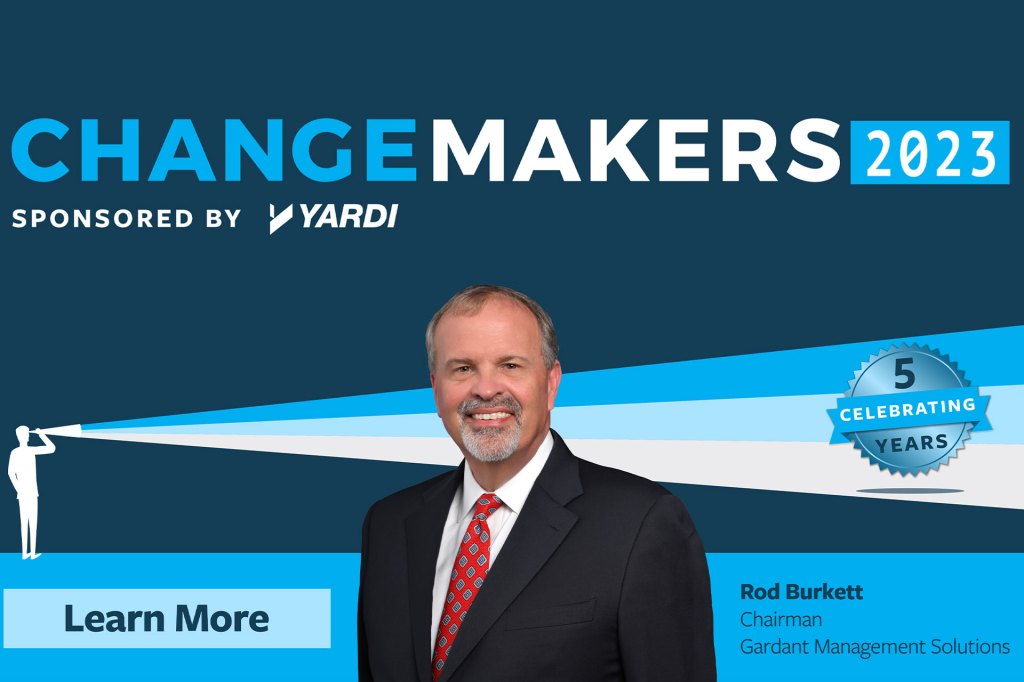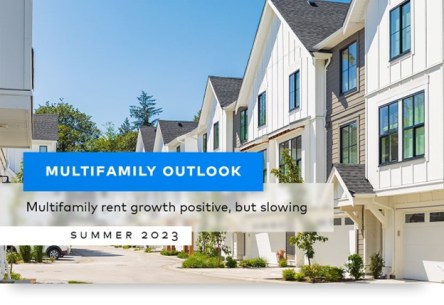Market corrections in Florida and California contributed to a month-over-month increase of average asking rents nationally by 41 basis points in May, states the latest Multifamily Forecast from Yardi Matrix. It was a decrease from the 44-basis-point MoM increase recorded in April and was prompted by actual decreases in asking rents in two regions: Florida markets that saw unbelievable growth during the pandemic and now face affordability problems, and California cities still struggling to find their post-pandemic footing. Five of the 10 worst-performing markets were in Florida (Southwest Florida Coast, Miami, Orlando, Jacksonville and West Palm Beach), and of the remaining markets that saw month-over-month declines, six were in California (metro Los Angeles, Sacramento, Eastern Los Angeles County, the East Bay, Orange County and the Inland Empire). Strong growth continues in many Midwestern and Northeastern markets: Portland, Maine, and Scranton–Wilkes-Barre both grew more than a full percentage point month-over-month. White Plains, Detroit, Urban and Suburban Chicago, Manhattan, Milwaukee, Rochester, Central New Jersey and Syracuse all saw asking rents grow more than 90 basis points from the previous month. The average apartment asking rent nationally was $1,726 in June, according to the Yardi Matrix National Multifamily Report. The update forecast lowers rent rate expectations for many larger markets in the West and Southwest and raises them for many midsize markets throughout the Midwest, Northeast and parts of the South. “The stalled-out return-to-office movement is putting a significant drag on Western markets with large numbers of knowledge-based workers, and economic uncertainty will continue to limit demand in those markets that have largely been driven by high-paying tech jobs,” states the report. As for those cities whose outlook improved: “As affordability continues to be a concern across the country and economic uncertainty prevails, these smaller markets will...
Honoring Earl Parker
Changemakers 2023
If you’ve been following this year’s Changemakers series, sponsored by us and presented by Senior Housing News (SHN), you’ve seen the range of inspiring honorees recognized so far. Each leader has been selected based on their ability to spark innovation, drive positive change and strategize ways to make the senior living industry a better place. The next batch of three honorees is no different, which includes Earl Parker — an inspiring trailblazer and Yardi senior living client! We’re excited to share a snapshot of his interview below. Yardi client Earl Parker named 2023 Changemaker Earl Parker is the CEO of Commonwealth Senior Living, a Virginia-based organization with 37 senior living communities to date. With three decades of experience in the industry, Parker knows how to pivot and grow in order to keep pace with the ever-evolving nature of senior living. And with that knowledge and expertise, he’s reached innovative new heights during his time at Commonwealth. In his thorough interview with SHN as part of the Changemakers series, Parker shares how he’s leading important changes at Commonwealth today, and explains why he believes driving continuous improvement across their communities is essential. SHN: Do you see yourself as a changemaker, and are you always excited to drive change? Parker: My first response was, no, I don’t see myself as that. My first reaction to that word, changemaker, is probably a dramatic, earth-shattering kind of change. But as I gave more thought to it, I could see it. My first mentor when I started working in hotels was a GM who I’m still in touch with, and they introduced me to the concept of continuous quality improvement and it’s been a key part of my life — work and personal — ever since then. It’s really a consistent leadership mindset that I have and try to bring to the organization, but it’s really continually focused on how we can try to make our communities a better place to live and a better place to work. I try to spend a lot of my time digging in on that, and I believe that if we can stay focused on that as an organization, that we can’t help but be successful. It’s a little bit of change every day, and ultimately that does create change. I certainly have changed a lot over the last 20-plus years. SHN: As you look across the rest of the senior living industry, do you think that it’s changing fast enough to keep up with the times? Parker: I may seem like a contrarian based on what a lot of I read other people saying, but I think it is. I think the industry evolves along with the demand. The markets that we’re in especially, we’re regularly engaging our residents, their families, associates, prospects, and getting feedback. I’ve been here at Commonwealth for 10 years, and there are many things that we’ve changed over the last 10 years: Dining, programming, physical plants, we’ve added hydroponic gardening, we’ve got a farm-to-table dining program, we’re using virtual reality with seniors. We’ve got robust Wi-Fi in all of our communities for residents and families to take part of. We have quartz countertops and stainless steel appliances. I think we have adapted and changed a lot over the last 10 years, and I think we’ll have to continue to do it. I’m not really sure what’s going on in San Francisco, or L.A., or New York City, but I think in the areas that we operate, we’ve changed a lot over the last 10 years, and I think we’ve got a product that’s appealing to the seniors and their adult children that are here today. We’ve all got to be responsible to continue to look at and monitor and evaluate where we think that demand is coming from in the future. As an industry, we’ve adapted pretty well. You could say...
New Rent Record
For Student Housing
The student housing sector continues to record strong rent growth and preleasing performance is up slightly over 2022, according to the latest National Student Housing Report from Yardi Matrix. As of June, 86.6 percent of beds at Yardi 200 universities were preleased for the upcoming fall term, a 5.2 percent increase from the prior month. June also marked the fifth consecutive month of annual rent growth over seven percent at Yardi 200 universities, at 7.2 percent. Given that 2022 held the previous rent record for student housing, obtaining more than seven percent growth off of previous record-high numbers is exceptional. The average rent per bed at Yardi 200 universities was $846 at quarter-end, a new all-time record. “Under the surface of solid overall fundamentals at the Yardi 200 level is mixed performance at individual schools, as some universities are doing exceptionally well while others fall short. Performance at the university level is mainly correlated to local supply-and-demand dynamics rather than higher-level trends,” state Matrix analysts. The student housing data set includes over 2,000 universities and colleges nationwide, including the top 200 investment grade universities across all major collegiate conferences. Known as the “Yardi 200,” it includes all Power 5 conferences as well as Carnegie R1 and R2 universities. However, the sector isn’t totally unscathed by current economic conditions. Transaction volume through the second quarter was down about 73 percent from the same time last year, a stark reminder of weakening economic sentiment. But that hasn’t slowed the off-campus dedicated student housing development pipeline, which expanded by approximately 28,000 bedrooms since January. Gain more insight in the latest Student Housing Report. Yardi Matrix covers multifamily, student housing, industrial, office and self storage property types. Email [email protected], call (480) 663-1149 or visit yardimatrix.com to learn...
Caring in Bristol
Combating Homelessness in England
Yardi is committed to supporting the community in every city where our offices are housed. Each year, the company distributes philanthropic aid to organizations selected by its employees. In 2022, Yardi offices supported more than 350 nonprofits worldwide. Let’s travel across the Atlantic Ocean to Bristol, England and introduce you to the Yardi-supported nonprofit, Caring in Bristol, founded in 1987. This organization finds gaps in Bristol’s provision for people experiencing or at risk of homelessness, working in creative and imaginative ways to create innovative projects to fill. Caring in Bristol takes its services where needed, working in community venues where people feel most comfortable. “Whether this is one of our pop-up food projects, housing-themed workshops, or a housing advice session, we can build relationships with people and identify and find effective ways to support them when their risk of homelessness increases,” said Luke Mitchell, corporate and community partnerships coordinator for Caring in Bristol. Caring in Bristol also distributes thousands of handbooks across the city, which help individuals, organizations and professionals instantly connect with support and information about homelessness, rough sleeping, debt and housing issues. Due to the pressure of cost-of-living issues, homelessness continues to build. Caring in Bristol has several projects and programs to combat homelessness. Bristol Goods diverts food that would otherwise go to waste but constantly needs to source new supplies, which is challenging. Early Doors works with people experiencing housing issues by providing information and advice that stops homelessness and reduces the costs to individual well-being and the city. Project Z is a youth program that assists and supports young people through and beyond periods of homelessness, intending to empower them to live out their fullest potential. “Project Z is Bristol’s only emergency youth shelter for those forced out onto...
Multifamily Rent Update
From Yardi Matrix
Multifamily asking rents grew another $7 last month, on average, but year-over-year growth fell to 1.8 percent, according to the latest Yardi Matrix National Multifamily Report. That’s down 70 basis points from May. Rents are buoyed by ongoing strong demand for units. Though down from the 2021 highs, occupancy rates are steady at 95 percent. The average asking rent was $1,726 in June. “Rents are growing within a normal seasonal pattern, albeit well below the post-pandemic boom and even below pre-pandemic trends,” say analysts. Rents were up $20, or 1.2 percent, in the second quarter, and are up $23, or 1.4 percent, during the first half of 2023. Single-family rental rates increased $5 in June to $2,103, while year-over-year growth fell 80 basis points to 1.3 percent. “Demand has remained strong, driven by the job market, which added 1.5 million jobs during the first half of 2023, and weak home sales, which are presenting a challenge to first-time home buyers,” states the report. A growing number of metros are now posting negative growth year-over-year, states the report. Nine of the 30 metros tracked by Matrix were negative in June, mostly in the Sun Belt and West, where demand has reverted to normal as new supply comes online. This month’s report includes an updated list of metros that will be of interest to multifamily investors, owners and managers. Gain more insight in the new Yardi Matrix National Multifamily Report. Yardi Matrix offers the industry’s most comprehensive market intelligence tool for investment professionals, equity investors, lenders and property managers who underwrite and manage investments in commercial real estate. Yardi Matrix covers multifamily, student housing, industrial, office and self storage property types. Email [email protected], call (480) 663-1149 or visit yardimatrix.com to learn...
Empowering Property Management
With AI Synergy
Artificial Intelligence was an important focus at the 2023 Apartmentalize conference. Utilizing AI will empower property management companies, but what is the difference between AI in operations? Augmented versus generative AI is used differently for specific tasks for property management. Let’s explore a synergistic approach that combines augmented and generative AI for enhanced customer experiences and drives operational efficiencies. Revolutionize property management with generative AI that emphasizes creative output in marketing efforts, including realistic property visualizations, creating virtual tours or personalized marketing content. For example, Fidelity vice president Sarah Hoffman recently spoke about how generative AI will improve efficiencies and creativity: “Generative AI can definitely take efficiency to the next level.” In contrast, augmented AI focuses on automation and data. The collaboration of both AIs can optimize property management workflows, reduce costs and improve productivity. Use AI in property management for leasing, lead nurturing and training employees. Generative AI can streamline resident communications and maintenance requests. ChatBots are being used at every turn for customer service and can also assist with leasing new residents. Most can even understand slang or misspelled words. A ChatBot will also help with lead nurturing by creating a heatmap so management can see what areas of the website prospects spend the most time on. ChatBots can answer more questions for maintenance requests so residents can say precisely what is needed for the work order. Use generative AI for marketing to furnish a vacant unit so a prospect has a better visual. Generative AI will also help collect pre-qualifications with an improved qualification rate. Save several hours in the office but remember that AI is here to help and not create more work. Unfortunately, with the good comes the bad. In a recent article by CNBC, generative AI is creating new cybersecurity threats. Generative AI is used to create more convincing scams with fake written content, digital content and documents. Do some research to avoid rising AI-based threats and consider an AI security tool. AI in leasing will also help with trends in the market, revenue and balancing supply and demand. Augmented AI is used for data analysis with a human touch. Augmented AI can be used for risk mitigation–facial recognition, and security. AI-powered surveillance systems and fraud detection algorithms ensure residents’ safe environments and property assets. Augmented AI will catch fraud early and identify potential risks or glitches. Send renewals easily and craft offers with data on market trends. Augmented AI can also help with marketing to predict demographics, location and movements. Use it for screening to allow more residents and acceptance rates. Student housing is already implementing AI and specialized technology, such as AI-powered surveillance systems, which is the evolution of technology for the multifamily sector and the type of business that should be embraced. “The new wave of renters are students, and students want to avoid talking to humans and prefer text, email and chats with more efficiencies,” said Connie Aldape, director of leasing centralization at Cushman and Wakefield. Augmented and generative AI can empower property managers by automating routine tasks, providing data-driven insights and enabling continuous learning through AI-driven training and knowledge-sharing platforms. Remember, AI will give support, but it will never replace humans entirely. Having that human touch will still be essential. Nobody can predict the future, but augmenting humans with AI will soon be a new...
Senior Living Stories...
Spotlighting Yardi Clients
Our senior living clients never fail to share sweet stories across their blogs and social media pages, so it’s only fitting that we reshare them here on The Balance Sheet! Spanning through spring and summer of this year, we’ve gathered a roundup of positive, uplifting stories to highlight our clients’ dedication to their community residents and staff (and their devotion to creating fun memories). We hope you enjoy! Life Care Services In an exciting LinkedIn post, Life Care Services (LCS) shared a trailer for their 2023 short film featuring several LCS residents. Created to celebrate over half a century of LCS history, “the film showcases the importance of finding passions later in life, cultivating relationships as we age, staying curious, and culminates with words of wisdom for us all,” says LCS on LinkedIn. The trailer, which you can find in the LinkedIn post, is an absolute must-watch! You’ll also find a short behind-the-scenes clip from the film shared in another LCS social media post, featuring an impressive piano rendition of Clair de Lune played by an LCS resident. Westmont Living This arts and crafts display at Westmont Living simply had to be shared, considering every piece was handmade by a community resident. Westmont posted a carousel of photos on their LinkedIn page showing residents posing with their creations (and browsing their fellow residents’ treasures). Be sure to visit Westmont’s LinkedIn to see more events and fun stories they’ve shared over the course of this year. Brightview Senior Living Brightview Senior Living recently shared a post with photos from their second annual “Bay Day” — an outdoor gathering where community residents and Brightview associates come together for a day in the sun. The photos shared show nothing but smiling faces. Brightview frequently shares community events...
Angela’s House
Everyday Wishes come true
Yardi is committed to supporting the community in every city where our offices are housed. Each year, the company distributes philanthropic aid to organizations selected by its employees. In 2022, Yardi offices supported more than 350 nonprofits worldwide. For the remainder of the year, we will bring you the stories of those organizations and insight into how they aid their communities. Today we travel to the east coast and introduce you to Angela’s House. This Yardi-supported nonprofit, founded in 1992 in Long Island, NY, assists families caring for children with special health care needs who are medically fragile, chronically ill or suffering from a life-threatening illness. The Policastro family founded the agency 31 years ago following the tragic crisis they experienced with their daughter Angela. This parent-based origin has affected the approach and philosophy Angela’s House applies to each family they assist. “We assist families caring for their children at home, and for those children that can no longer live at home, we have Angela’s Houses,” said Bob Policastro, executive director and founder of Angela’s House. Home Care helps to coordinate the complex array of home care services needed to support children living at home with their parents. This may include services such as: Medical equipment Nursing support Therapies and medications Handicapped accessible homes Angela’s House currently works with over 700 fragile children in the community. The children who live in the homes are cared for in a warm, loving environment suited to accommodate their complex physical and medical needs. These homes have 24-hour nursing care. “We currently have three homes in East Moriches, Smithtown and Stoney Brook. They are the first of their kind in New York State,” said Policastro. He continued, “The Stony Brook home can care for children that need a...
Arm Services
Ergonomically Sound Workplaces
The importance of proper workplace ergonomics is one thing that hasn’t changed since the pandemic’s onset – whether you’re still at home or back in the office. The concept of ergonomics – a word coined by a Polish professor in 1857 – dates to chair and tool designers in ancient Greece. Attention to workplace injuries grew in the early 20th century, as repetitive factory work increased strain injuries, and accelerated further during World War II, when the assembly of complex weapons systems and equipment required a high degree of decision-making, attention, situational awareness and hand-eye coordination. The war marked the point at which “ergonomics took a true turn into the concept that we understand today with deeper research to follow,” notes OMT-Veyhl, a Holland, Mich.-based office furniture manufacturer. By the 1980s, the ubiquity of computers in offices had led to a spate of arm, neck and back injuries. That’s because computer work tends to involve repetitive movements that place strain on hands, wrists and other areas of the body. These problems continue, in commercial and home offices. Creating an ‘ideal fit’ That’s where ergonomics comes in. This discipline focuses on ensuring correct placement of chairs, desks, monitor stands and other elements of a workstation to avoid pain; tingling or numbness in the hands, wrists or shoulders; and other afflictions. “Ergonomics is the science of establishing an ideal fit between a worker, their working environment and the tasks they carry out. Office ergonomics, then, is simply about making sure that office employees have the correct furniture, equipment and working conditions to be able to do their jobs effectively and comfortably,” says British CMD Ltd., a British power systems manufacturer. Taking the right ergonomic measures, the Mayo Clinic adds, means “you’re not doomed to a career...
Veterans Sportsman Alliance...
Supporting Vet Health and Well-being
Yardi is committed to supporting the community in every city where our offices are housed. Each year, the company distributes philanthropic aid to organizations selected by its employees. In 2022, Yardi offices supported more than 350 nonprofits worldwide. Today we introduce you to the national Veterans Sportsman Alliance (VSA), founded in 2013. This Yardi Boise-supported nonprofit assists returning combat veterans as they develop a post-service, purpose-driven lifestyle. VSA also works with family members to help them better understand veterans’ challenges and how better to conquer these situations on a path to success. “Our focus is the veterans’ and their families’ health and well-being. My phone is on 24/7/365,” said Brett Johnson, Co-founder and CEO of Veterans Sportsman Alliance. Veterans Sportsman Alliance will continue to fine-tune its existing programs and explore new ways to help veterans and their families in the coming years. “We will work to expand community awareness of the needs and challenges our Heroes face,” said Johnson. Funding from Yardi has helped drive VSA to success. “Your donations change and save lives! There is no greater cause,” exclaimed Johnson. Saving Veteran Lives Veterans Sportsman Alliance’s most tremendous success has been veterans explaining how they “saved their life” during periods of depression and turmoil. “There is nothing greater than a veteran looking you in the eye and thanking you for ‘talking them off the cliff,’” shared Johnson. For anyone interested in opportunities to volunteer, it is best to talk to the local representatives of VSA for direction. Find future non-profit profiles...
Introducing Competitive Analysis
New RentCafe Senior CRM Functionality
We’re constantly evolving our solutions in the Yardi Senior Living Suite, whether we’re enhancing workflows or creating new functionality altogether. And we recently released an exciting feature in RentCafe Senior CRM, our mobile-friendly sales and marketing solution — a feature called competitive analysis. Our senior living clients are seeing major successes with this dynamic new feature, but in case you haven’t explored it yet (or if you’re new to RentCafe Senior CRM), we thought we’d share what it does — and what the benefits are. Meet competitive analysis Senior living operators know all too well the importance of assessing competing communities. It’s crucial to understand why one community may be attracting new prospects more successfully, or even enticing your current residents to make a switch. Unfortunately, assessing this information is challenging when you don’t have the data you need — or if your data isn’t organized, easy to retrieve and error-free. That’s where our competitive analysis feature comes in. We offer the ability to input the data you’ve collected on your competitors — including things like community amenities, care-level incentives and reputation — then view your own community’s attributes in comparison. All data is presented in an attractive, easy-to-analyze format. And once you’ve entered competitor data once, it stays fixed in one secure place, making it easy to access and edit in the future. Something particularly exciting with the competitive analysis functionality is the ability to track specific competitors in your lost lead analysis. This centralized, detailed information can help your future market efforts by highlighting what the major differences are between you and your competitors. The competitive analysis workflow is also completely configurable, allowing you to customize fields based on which categories you prefer to grade competitors on (we used client feedback to drive the customization options we created). Introducing self-competitor functionality Thought the functionality above was great? There’s more! RentCafe Senior CRM also gives you the option to view how your own communities stack up against each other. And rather than inputting data like you would for competitors, your own community’s data is automatically drawn from Yardi Voyager Senior Housing since RentCafe Senior CRM is a fully integrated solution. That means you’re always viewing the most up-to-date, accurate information when doing competitive analysis, and you’re not devoting hours to pulling information from multiple sources. However you choose to use competitive analysis, the feature helps you centralize important information, streamline reporting and compare communities with ease. With organized and centralized data at your fingertips, you’re equipped to make faster, informed decisions for your community’s benefit — decisions to help your community stand out from the crowd. Discover more and connect with our team If you’re new to RentCafe Senior CRM and would like a personalized demo, including a closer look at competitive analysis, reach out anytime. If you’d like to start with a high-level overview of the solution, explore our product...
Fur & Bytes
Unleashing Technology for Pets
Let technology do its work and have happy residents, less pet damage, plenty of renewals and profitability. Earlier this month, Apartmentalize highlighted the latest technology property owners and companies are embracing for their pet residents. Let’s explore these opportunities for innovation. Paws and Effect. Many property management companies are using the latest technology for their furry residents and seeing immense success. Starting with pet DNA testing, management can use these tests and know which poop is coming from which dog. With this knowledge, management can decide whether to issue warnings to pet owners or give them an extra monthly fee. This eliminates all un scooped pet waste around the property, ultimately leading to happier residents. Pet screening has also been implemented in some properties, giving prospective residents a quick survey that will track vaccination records and behavioral affidavits. Those who score a lower score must pay a high pet rent. Those with a high score can have zero to minimal pet rent. This allows property managers and owners to set high standards, eliminating the need for breed restrictions and allowing for more pet inclusivity. Those who offer no pet rent with high screening scores will be happy and likely renew their lease contracts. Plus, word-of-mouth marketing from grateful tenants will be significant. Another way to waive fees or pet rent is if those looking to be pet owners adopt a rescue dog or cat. Host a pet adoption day at the property. Those who adopt that day can get a discount or waived fees and rent. This not only helps the community for those pets in need but also shows that management cares and wants to see residents happy while living at the property, which will lead to retention and profitability. Oppawtunities to innovate....
Taking Charge
How Businesses Leverage Credit Cards
Business credit cards, which enabled close to $700 billion of spending in 2022, are as much a fixture in commerce as the personal cards used by the vast majority of adult Americans. “Both merchants and consumers would be completely stuck without the little plastic cards, with slowed transactions and virtually no online purchases,” according to Block, a financial services technology provider based in San Francisco. Portrait of African-American male holding cell phone in one hand and credit card in other, making transaction, using mobile banking app during lunch at cafe. His working papers and tablet pc are on the table. Online payment and shopping concept. Corporate cards first emerged in the late 1970s – 30 years after the first personal credit cards – and became widely adopted about 20 years later. In 1998, 37% of small businesses reported using a corporate card; 67% did less than 10 years later. Enhanced by chip systems and other safeguards, business credit cards are now available in digital as well as physical forms. Broad value for businesses All types of business owners, from sole proprietors, freelancers, small and large businesses, to LLCs and corporations, use credit cards for supplies, office furniture or travel. Corporate cards are useful for building credit, earning rewards and keeping overhead low by enabling large purchases with special financing. Their issuers often offer sign-up bonuses, rewards points or cash back that businesses can redeem for a variety of purposes. Card issuers’ eligibility criteria for corporate cards, such as personal and business credit histories, are similar to those applied to individual applicants. Business cards typically come with higher credit limits than personal cards to accommodate larger incomes and expenses. Some issuers offer business owners extended periods of interest-free financing longer than the typical period for...
Save Money, Drive Efficiency
See how with Aspire
Staying competitive in the property management industry requires comprehensive employee training programs. However, developing and administering training can be costly. Streamline training processes and reduce expenses with an advanced learning management system (LMS) from Yardi Aspire. Read on to see how Yardi Aspire, with its customizable training content and advanced features, empowers property management organizations to save money, enhance efficiency and improve employee performance. Reducing turnover costs Comprehensive training plays a crucial role in retaining talent. Studies show that employees who receive job skills and career development training are two times more likely to stay with an organization. Without formal training, turnover rates increase. In the property management industry, where turnover rates reached 26% in 2023, replacing one employee costs approximately 1.5x their annual salary. By providing comprehensive training through Aspire, companies help employees gain new skills that are vital to operational success, increasing employee productivity, promoting innovation, creating higher morale and reducing turnover. Efficient compliance training Compliance training is essential for property management organizations to avoid fines, legal issues and reputational damage. Aspire offers unlimited access to comprehensive training modules on topics such as harassment prevention, fair housing laws and workplace safety. These modules help companies ensure their properties are safe and welcoming. By using the customizable compliance content in Aspire, companies can avoid the cost and hassle of purchasing off-the-shelf external training that could run $125 to $200 per person per year. Customizable content from Aspire allows organizations to incorporate their policies and procedures, providing targeted and cost-effective training within their centralized learning environment. Savings in training development Aspire clients can take advantage of hundreds of engaging courses for training on Yardi software, industry knowledge, regulatory compliance, safety, professional skills and more. Developing a single elearning course with moderate engagement typically takes a minimum of 74 hours. With Aspire, clients who use just 25% of the Aspire catalog save an impressive 22,200 hours in training development time over the first two years. This time savings translates to a significant reduction in costs, as it would take a full-time instructional designer over 11.5 years to produce the same content included in Aspire. Streamlining live training management Managing live training events involves various tasks such as setup, registration management, attendance tracking and reporting. Aspire integrates with leading online meeting and webinar providers, automating event setup, calendar synchronization and attendance tracking. This integration reduces administration time by 75%, saving clients approximately 9,600 hours during the first two years. Additionally, clients can leverage Yardi’s expertise by integrating over 2,400 free webinars into Aspire, expanding training options without the need for additional trainers or internal resources. Efficient training administration Manually assigning training courses to employees can be time consuming, especially when dealing with a large workforce. Efficient user data imports and automated training assignment rules from Aspire allow clients to configure the system to import user data from HRIS or payroll systems. This automation eliminates the need for administrators to manage user accounts and training assignments manually. The time saved by using Aspire’s automations allows trainers and administrators to focus on more strategic projects. Optimizing on-the-job training Relying on individualized onboarding without a dedicated training team can be costly and lead to knowledge and skill gaps. A mentorship module from Aspire helps strike the right balance between trainer involvement and learning autonomy. By providing structured, independent learning activities to deliver knowledge and basic skills, senior employees can spend more time evaluating and fine-tuning skills for better results. This approach reduces senior employees time spent with new hires by up to 50%, allowing a company that hires one to two employees per month to regain 4.5 months of productive work time from their most experienced staff. What’s next? Yardi Aspire offers a comprehensive learning management solution for leading property management companies, enabling them to optimize training development and administration. With customizable training content, advanced features and integrations, organizations can significantly reduce operational expenses,...
Client Spotlight
Matt Berlin, Paragon Real Estate Investments
We recently caught up with Matt Berlin, CFO for Paragon Real Estate Investments, for perspective on the drivers and results of implementing new accounting software for managing real estate investments. Matt, what is Paragon’s business focus? We’re a privately held company that manages and invests funds on behalf of family offices, institutional investors and high-net-worth individuals. We manage our growing portfolio of stabilized assets through our flagship fund, Paragon Real Estate Fund. The Paragon team is based in La Jolla, Calif., and owns commercial property in key urban markets nationwide. What challenges did you face in your real estate investment operations? As our investor base grew significantly, we found that doing property accounting manually on spreadsheets was cumbersome, time-consuming and mistake-prone. That prompted us to seek a new software solution capable of streamlining journal entries, general ledger updates, distributions and other investment operations. Then you adopted Yardi Investment Accounting. What did that do for you? It automated our asset, investment accounting and investment lifecycle within a single connected solution. Yardi Investment Accounting is the only one-stop shop I’ve seen in the market. What results have you seen from the implementation? The solution produces faster reporting, helps us formulate our investment strategies, satisfies investors and enables full transparency from investors through assets. Its seamless integration with Yardi Voyager means we don’t have to worry about mistakes from manually entering data into spreadsheets or whether disparate systems can communicate with each other and make the various general ledgers match. Investment Accounting also streamlined our annual net asset value calculations by automatically incorporating the current share price. Can you cite an example of Investment Accounting’s utility? When we executed a capital call, we didn’t need to set up new spreadsheet formatting. We no longer needed to open...
Introducing Rod Burkett
Changemakers 2023
“I think as human beings, we have some built-in resistance to change. I think as businesses, we owe it to our customers to never become extinct. We have to change and be both proactive and reactive to all that internal and external forces that impact our business.” Yardi client Rod Burkett — a 2023 Changemaker — recently spoke these words in an in-depth interview with Senior Housing News (SHN). Burkett’s interview, much like all the interviews in the annual Changemakers series, features motivational stories, insights and advice applicable to senior living. We’re pleased to share a highlight of Burkett’s interview below, but you can head to his full interview with SHN for more insights. Yardi client Rod Burkett named 2023 Changemaker As chairman of Gardant Management Solutions, the 25th largest senior living operator in the country, Rod Burkett is an expert when it comes to driving strategic, effective change. He’s led the organization since its founding in 1999, and through his interview with SHN, Burkett shares what he’s learned along the way. SHN: Can you talk about a time when you tried to execute a change and things didn’t go according to plan? How did you pivot, and what did you learn as a leader? Burkett: Yes. The one example that really jumps out at me is maybe like a lot of management companies, as we got bigger, we added more resources. Like most companies, we have a regional approach, with regional ops, regional marketing, regional clinical, and so forth. We added all these resources as subject matter experts. The whole intention is to create more resources, more support for our communities but I think we didn’t create clarity because where is the decision being made? Are these people that are here to help? Are they making the decision? Is the local ED making the decision? Was all with good intentions, but the unintended consequences of confusion in decision-making. We talked about empowering that decision to be made at the local level. We talked about a good game. That was the change is to not let the gray area, lack of clarity who’s truly making the decision. We talked about it, but the talk didn’t work. I think where we failed was we didn’t truly embed that in our culture and so as we added more people, I think it just, we very often weren’t on the same team. It was them and us, corporate versus at the community level. We really had to take a step back and pivot and we truly had to embed this in our culture and it’s still a work in progress. We’ve been working at it for a couple of years. When I’m dealing with this local community, I’m on their team and we’ve created questions that we pose to all of our staff at every staff meeting. Little wristbands that talk about being on the community team. Regardless of how I identify myself, especially what subject matter expert I am, when I’m working with that local community, I’m on their team. Not only did we talk about it, we truly had to make it embedded in our culture and have each individual talk about it and what it meant to them. I would say that’s the one that really we spent the most energy and time truly making a change where we would create the decision-making at the local community level and have our staff truly saying, “We’re here to support you.” You’re the ones on the ground at the local community, and it’s taken a lot of effort to create that change. SHN: What is a word of advice for managing resistance to change? Burkett: I think as human beings, we have some built-in resistance to change. I think as businesses, we owe it to our customers to never become extinct. We have to change and be both proactive and reactive...
Pappas Kids
Schoolhouse Foundation Benefits Kids
Let’s head west and introduce you to the Pappas Kids Schoolhouse Foundation of Coolidge, Arizona, founded in 2005. Pappas Kids believes that education is the only way to break down the barriers that poverty and homelessness create. Pappas Kids strives to open the doors of educational opportunities to homeless, underprivileged, at-risk youth and families under the poverty threshold. The organization offers educational enhancing assistance programs to underserved children throughout Arizona, all of which are intended to alleviate obstacles that prevent children from completing their education. “One of our most notable types of support is our private school tuition scholarship program. This gives children an opportunity to decide what type of educational environment would best help them succeed,” said Dayna Sandoval, executive director of Pappas Kids. In addition to scholarships, Pappas Kids ensures children are adequately equipped and prepared for school by distributing more than 9,500 backpacks filled with school supplies throughout schools and communities across ten counties statewide. Pappas Kids partner with military members, public safety officers and school district officials to help distribute this assistance successfully. “It is our mission to alleviate obstacles that prevent these children from being successful and confident academically, and we believe that lessening their worries in the classroom, at home and during the holidays helps them not only have a more enjoyable educational experience but increases the likelihood of continuing their journey academically,” shares Sandoval. Pappas Kids distribute gifts that promote family togetherness, literacy and healthy problem-solving, creating a memorable tradition for children and families to cherish for years. These gifts include: A book for them to read together (promoting literacy) Board game (promoting healthy problem-solving) Soft blanket and stuffed animal Hot cocoa Popcorn Cookie Tin Gift card (to help establish traditions) These gifts provide an opportunity to...
Navigating Pharmacy Partnerships
Senior Living White Paper
Today’s seniors have more clinical needs than ever before, which means medication management is more challenging than ever — and medication errors are more likely — in senior living communities. That is, when communities lack the integrated technology (such as Yardi EHR) needed to optimize coordination with pharmacies. Our latest white paper with Senior Housing News (SHN) covers more — exploring the vital connection between pharmacy and resident care and sharing why an integrated EHR solution is critical in optimizing pharmacy coordination. The resource was created to help operators navigate the ever-evolving world of senior living as it relates to medication management. We put together a highlight below with key points covered in the white paper, but we encourage you to read the resource in full for more insights! New white paper: Navigating pharmacy partnerships in senior living While the need for pharmacy integration is related to a variety of factors, the pandemic has been the most significant. Specifically, since COVID-19 delayed many prospective senior living residents from moving into communities, a resident population already rife with clinical needs has grown more vulnerable. And with that higher acuity comes a host of new challenges in medication management, and thus the urgent need for pharmacy integration. That’s why we joined SHN to publish this pharmacy-focused white paper. It examines the medication-related challenges present in senior living today and guides operators on how to maximize pharmacy relationships and streamline medication management. It stresses the importance of implementing a single connected EHR solution. The white paper looks at: Key reasons operators are switching to digital record keeping Why electronic pharmacy coordination matters through 2023 and beyond Top benefits of a single connected pharmacy solution What makes Yardi software a differentiator Yardi EHR in action at Senior Lifestyle In sharing the power of Yardi EHR, the white paper includes insights from Fil Southerland, our director of healthcare solutions, as well as Diane Dayne, director of clinical informatics at Senior Lifestyle — a dedicated Yardi client. Read the entire white paper Be sure to read the white paper — Navigating the New World of Senior Living & Pharmacy Partnerships — for a closer look at Yardi EHR and its role in pharmacy coordination. If you have any questions for us about Yardi EHR or the Yardi Senior Living Suite in general, fill out the form listed here to schedule a personalized...
Multifamily Outlook
Insight from Yardi Matrix
Multifamily rents continued to increase through the first half of 2023, despite challenges for the sector and continuing economic uncertainty. But job growth has remained robust and new households keep forming, creating apartment demand and ongoing rent growth. “We anticipate that rents will continue to increase modestly over the course of the year as demand has firmed, albeit at a more moderate rate in line with historic growth levels,” say Yardi Matrix experts in a newly released U.S. Multifamily Outlook. Through the first five months of 2023, U.S. asking rents rose $17, or 0.9 percent, with year-over-year growth falling to 2.6 percent. “We expect continued deceleration, with rent growth of 2.5 percent for the full year,” states the outlook. The average U.S. apartment rent reached an all-time high of $1,716 in May. Challenges for the sector include slowing demand, growing issues with affordability, slower population growth and competition from a large number of new units coming online through 2024. The capital side of the industry has suffered due to heightened interest rates, which show little sign of decreasing in the near-term. Property values are down 15-20 percent from their peak and are still declining due to the higher cost of capital. New deliveries will be high at least through the end of 2024, as the 1 million units under construction come online. New starts are now declining, however, because debt is more expensive and fewer banks are financing construction. Household formation, which drove the 22 percent cumulative growth in U.S. asking rents over 2021 and 2022, has slowed but remains positive. Although some pandemic demographic trends are moderating, the desire for more space to balance living, working and family appears to have staying power and should continue to drive demand. Demand is also boosted...
AI Alt Text Generator
For RentCafe websites
Great news for RentCafe websites on the RentCaffeine platform! We’ve added an AI alt text generator that makes uploading new photos faster and easier. This tool creates alternative text — more commonly known as alt text — automatically for you. Alt text is copy that describes images using words, making your website more accessible to people who have a hard time viewing or understanding pictures. That’s right, as promised by countless articles, artificial intelligence is here to help you! (As a bonus, we promise that this version of AI has no aspiration to take over the world.) Keep reading to learn what it is, why it’s important and how to use it. Then check out some client feedback about our new AI tool for RentCafe websites. AI tool for alt text Our AI tool for alt text automatically writes image descriptions for you, so you don’t have to. It will create high-quality image descriptions of new photos you add to your media library. It will also generate descriptions for existing photos that are missing alt text, helping you quickly fill accessibility gaps. Why it’s important Alt text is alternative text that that describes the appearance or function of an image online. It’s important to people and search engines alike. Alt text is read aloud by screen readers used by visually impaired users. If an image fails to load on your site for any reason, the alt text will be displayed so people know what’s supposed to be there. Alt text is also crawled and indexed by search engines to better understand the content of your page. Unfortunately, it’s often overlooked or skipped in the process of uploading photos. Entering alt text can be time consuming when you’re working with more than a handful of images. Manually entering alt text also adds potential for typos and other human errors. Mislabeled images are just as bad as unlabeled images. Our AI alt text generator fixes this, making the process of adding alt text to your images easy and instant. “I’m proud that RentCafe continues to build accessible websites. We want to ensure our websites are inclusive, and the AI alt text generator will help our clients with that,” said Nomo Nagaoka, project manager for RentCafe. “Although alt text is simple to manually set up, it is often missed — either it gets forgotten or people run out of time. But now we’ve solved for this. Any time an image is uploaded, through our AI solution, we’re generating recommended alt text. It’s easy to review and edit as necessary. No images will be without alt text moving forward, and our clients will spend less time trying to manually write out descriptions of the images.” (It’s only fair to share that when Nomo first previewed this technology to our audience at OutREACH Live in Palm Springs, the attendees actually started applauding mid-presentation.) How to use it As stated earlier, you can add auto-generated alt text to images that you upload to your media library, as well as existing images that are missing alt text. The automated alt text generator was enabled for all clients in the March release, so log in and check it out if you haven’t made website updates lately. You can review and accept AI-generated alt text from the media library, Site Editor or your SEO Dashboard. When alt text has been auto-generated, a message appears below the image alt textfield that says, “This is auto-generated alt text.” It’s a best practice to quickly assess the auto-generated text to make sure it works for the image being described. Review your alt text and either confirm or modify it before saving your changes. If you save changes, the modified alt text gets saved and the “This is auto-generated alt text” message will be removed. Does it help with SEO? Kind of. By default, having some alt text is better than having none at all. Search engines like...

